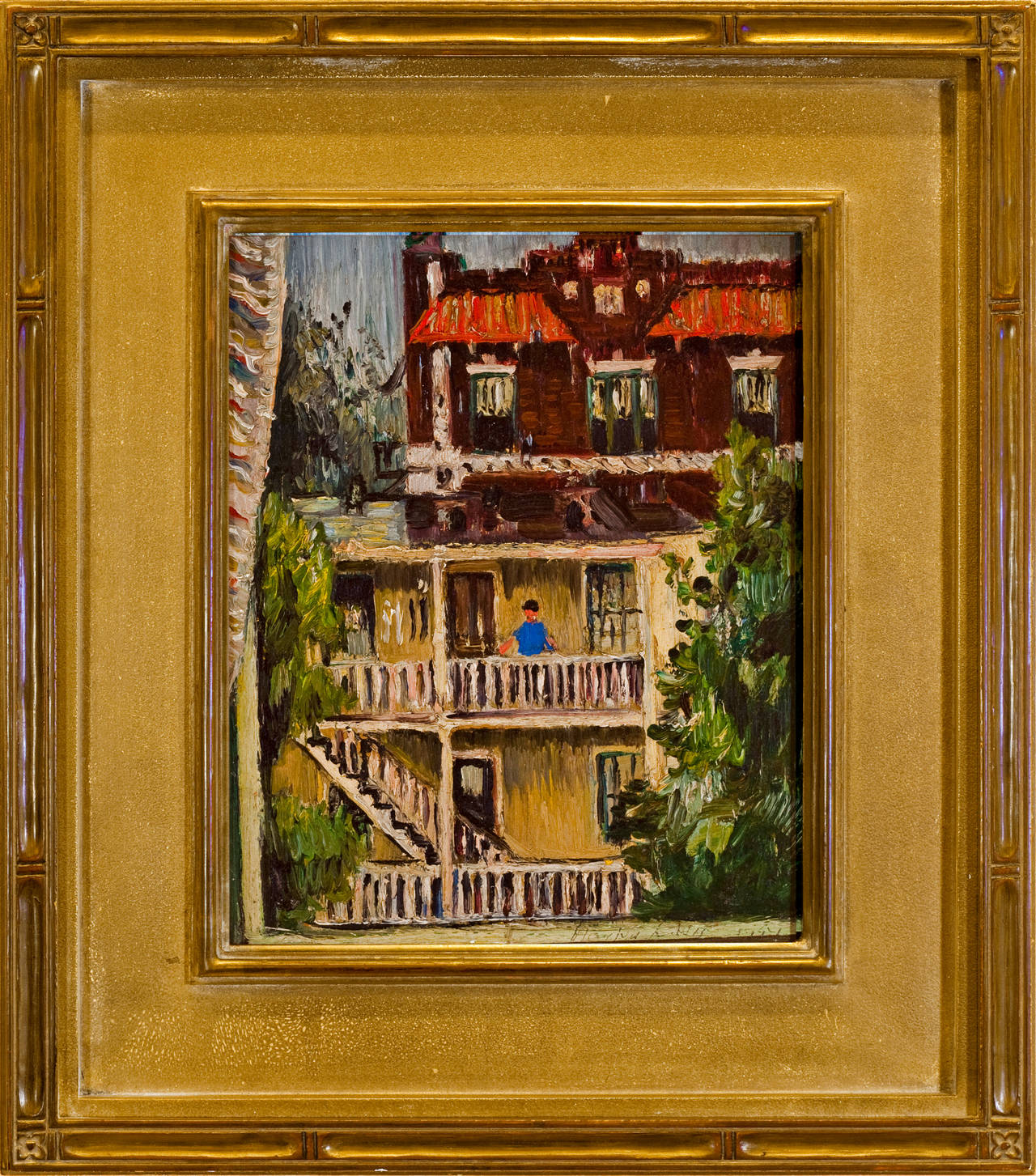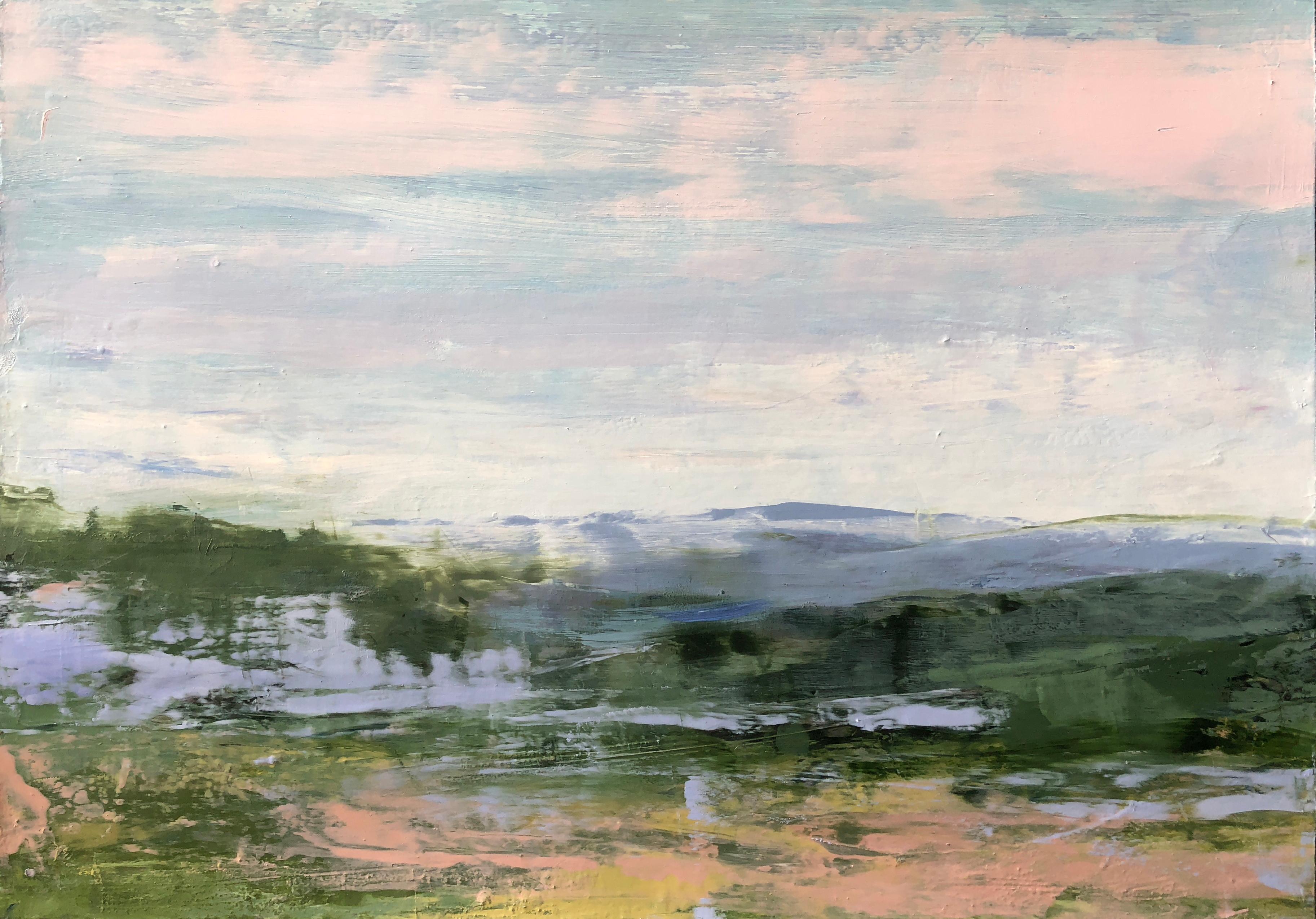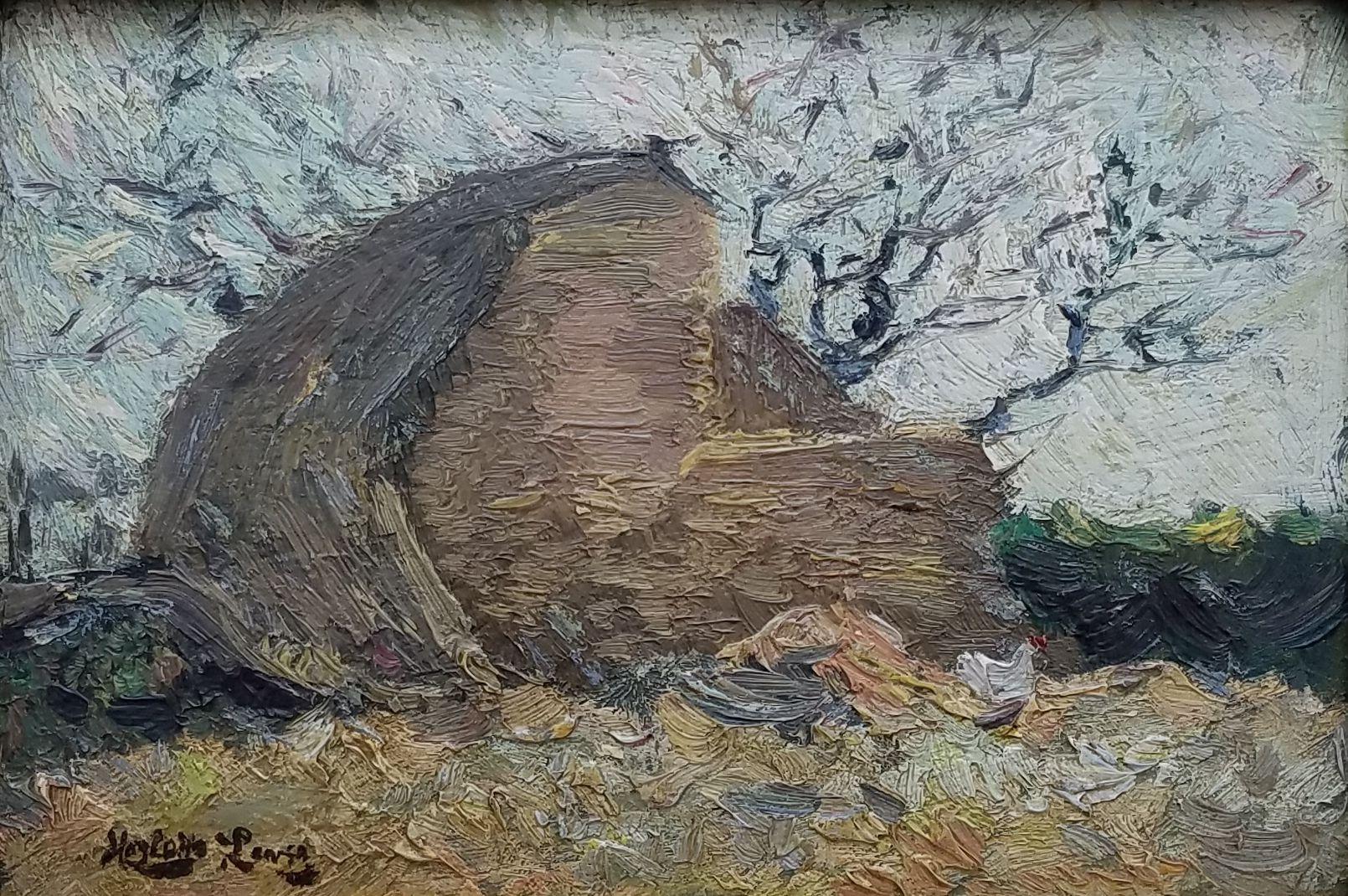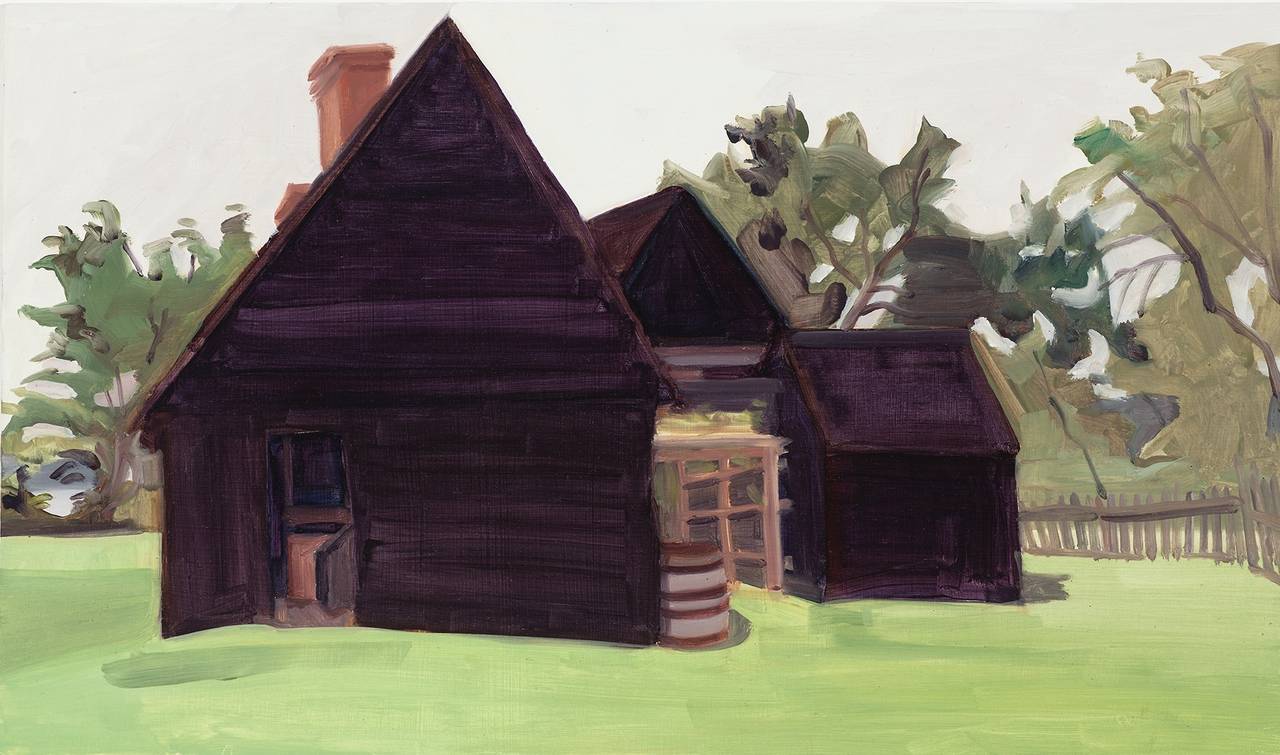Items Similar to "Up the Valley"
Want more images or videos?
Request additional images or videos from the seller
1 of 5
Daniel Garber"Up the Valley"Circa 1941
Circa 1941
About the Item
In an original Harer frame.
Illustrated in "Daniel Garber Catalogue Raisonne" Vol. II, pg. 271, and in book titled "Blue Chips", pg. 33
Jim’s of Lambertville is proud to offer this artwork by:
Daniel Garber (1880-1958)
One of the two most important and, so far, the most valuable of the New Hope School Painters, Daniel Garber was born on April 11, 1880, in North Manchester, Indiana. At the age of seventeen, he studied at the Art Academy of Cincinnati with Vincent Nowottny. Moving to Philadelphia in 1899, he first attended classes at the "Darby School," near Fort Washington; a summer school run by Academy instructors Anshutz and Breckenridge. Later that year, he enrolled at the Pennsylvania Academy of the Fine Arts. His instructors at the Academy included Thomas Anshutz, William Merritt Chase and Cecilia Beaux. There Garber met fellow artist Mary Franklin while she was posing as a model for the portrait class of Hugh Breckenridge. After a two year courtship, Garber married Mary Franklin on June 21, 1901.
In May 1905, Garber was awarded the William Emlen Cresson Scholarship from the Pennsylvania Academy, which enabled him to spend two years for independent studies in England, Italy and France. He painted frequently while in Europe, creating a powerful body of colorful impressionist landscapes depicting various rural villages and farms scenes; exhibiting several of these works in the Paris Salon.
Upon his return, Garber began to teach Life and Antique Drawing classes at the Philadelphia School of Design for Women in 1907. In the summer of that same year, Garber and family settled in Lumbertville, Pennsylvania, a small town just north of New Hope. Their new home would come to be known as the "Cuttalossa," named after the creek which occupied part of the land. The family would divide the year, living six months in Philadelphia at the Green Street townhouse while he taught, and the rest of the time in Lambertville. Soon Garber’s career would take off as he began to receive a multitude of prestigious awards for his masterful Pennsylvania landscapes. During the fall of 1909, he was offered a position to teach at the Pennsylvania Academy as an assistant to Thomas Anshutz. Garber became an important instructor at the Academy, where he taught for forty-one years.
Daniel Garber painted masterful landscapes depicting the Pennsylvania and New Jersey countryside surrounding New Hope. Unlike his contemporary, Edward Redfield, Garber painted with a delicate technique using a thin application of paint. His paintings are filled with color and light projecting a feeling of endless depth. Although Like Redfield, Garber painted large exhibition size canvases with the intent of winning medals, and was extremely successful doing so, he was also very adept at painting small gem like paintings. He was also a fine draftsman creating a relatively large body of works on paper, mostly in charcoal, and a rare few works in pastel. Another of Garber’s many talents was etching. He created a series of approximately fifty different scenes, most of which are run in editions of fifty or less etchings per plate.
Throughout his distinguished career, Daniel Garber was awarded some of the highest honors bestowed upon an American artist. Some of his accolades include the First Hallgarten Prize from the National Academy in 1909, the Bronze Medal at the International Exposition in Buenos Aires in 1910, the Walter Lippincott Prize from the Pennsylvania Academy and the Potter Gold Medal at the Art Institute of Chicago in 1911, the Second Clark Prize and the Silver Medal from the Corcoran Gallery of Art for “Wilderness” in 1912, the Gold Medal from the Panama-Pacific Exposition in San Francisco of 1915, the Second Altman Prize in1915, the Shaw prize in 1916, the First Altman Prize in 1917, the Edward Stotesbury Prize in1918, the Temple Gold Medal, in 1919, the First William A. Clark Prize in 1921, the Gold Medal from the Philadelphia Art Club in 1923, the Carnegie Institute Bronze Medal in 1924, the Gold Medal of Honor in 1929, the Jenny Sesnan Gold Medal in 1937, the Pennell Medal in 1942, and the Pennsylvania Academy Fellowship Award in1947 among many others.
Daniel Garber and Edward Redfield are known by most art enthusiasts as the two leading figures associated with the New Hope Art Colony. This is a correct assessment, but in the broader scope, as key figures in twentieth century American Art, their importance is equally paramount. As this group, once considered regional, secures it’s place in history, painters like Garber and Redfield are destined to be considered the true American Masters by the international art world.
Garber's work is included in nearly thirty museum collections nationally and this number is growing. He is also the first of the "New Hope School" painters to exceed the million dollar mark at auction which occurred in 2003.
Source: New Hope for American Art, James M. Alterman
- Creator:Daniel Garber (1880-1958, American)
- Creation Year:Circa 1941
- Dimensions:Height: 27 in (68.58 cm)Width: 31 in (78.74 cm)Depth: 2 in (5.08 cm)
- Medium:
- Movement & Style:
- Period:
- Condition:
- Gallery Location:Lambertville, NJ
- Reference Number:
About the Seller
5.0
Vetted Seller
These experienced sellers undergo a comprehensive evaluation by our team of in-house experts.
Established in 1997
1stDibs seller since 2014
36 sales on 1stDibs
Typical response time: 6 hours
- ShippingRetrieving quote...Ships From: Lambertville, NJ
- Return PolicyThis item cannot be returned.
More From This SellerView All
- "The Floor We Live in"By Hayley LeverLocated in Lambertville, NJJim’s of Lambertville is proud to offer this artwork. Signed and dated lower right. Hayley Lever (1876-1958) Hayley Lever's exceptional career path took him from the shores of ...Category
1930s American Impressionist Landscape Paintings
MaterialsPanel, Oil
- "Clouds for Autumn"By Peter SculthorpeLocated in Lambertville, NJJim’s of Lambertville is proud to offer this artwork by: Peter Sculthorpe (born 1948) Peter Sculthorpe was born in Ontario, Canada, in 1948. His talent was evident even as a chi...Category
21st Century and Contemporary American Impressionist Landscape Paintings
MaterialsOil, Panel
- "The Delaware Canal"By Alice B. SotterLocated in Lambertville, NJJim’s of Lambertville is proud to offer this artwork. Complemented by a Ben Badura Frame Illustrated in "New Hope for American Art" page 499 Signed lo...Category
20th Century American Impressionist Landscape Paintings
MaterialsBoard, Oil
- "City Scene"By Hayley LeverLocated in Lambertville, NJJim’s of Lambertville is proud to offer this artwork. Signed and dated March 1943 lower right. Hayley Lever (1876 - 1958) Hayley Lever's exceptional career path took him from th...Category
1940s American Impressionist Landscape Paintings
MaterialsBoard, Oil
- "Barn with Red Doors"By Joseph BarrettLocated in Lambertville, NJIllustrated in "Joseph Barrett, The Prime Years 1970s - 1990s", pg. 28, plate #031. Jim’s of Lambertville is proud to offer this artwork by: Joseph Barrett (1936 – ) Joseph Barrett was born in Midland, North Carolina, in 1936 and studied at the Massachusetts College of Art in Boston and at the Tyler School of Art in Philadelphia. Barrett, now of Lahaska, Pennsylvania, has been painting his entire adult life. His favorite subjects include the landscape surrounding New Hope and many local landmarks often encompassing figures into his compositions. Barrett utilizes a heavy impasto and his palette bears similarities to that of Fern Coppedge and George Sotter. Barrett’s paintings are always found in unique and somewhat charming handmade frames designed by the artist and finished in metal leaf. A living contemporary of the no longer living “New Hope School” impressionist painters, Joseph Barrett resides outside of New Hope above his old-fashioned antique shop and studio. Entering Barrett’s shop is like taking a step back in time. Inside this cluttered and dusty haven of treasures from the past, is a studio spanning only four by eight feet. This little studio, containing cans of old brushes and hundreds of used paint tubes...Category
Late 20th Century American Impressionist Landscape Paintings
MaterialsOil, Canvas
- "Pine Grove Near Pipersville"By Joseph BarrettLocated in Lambertville, NJIllustrated in "Joseph Barrett, The Prime Years 1970s - 1990s", pg. 45, plate #052. Jim’s of Lambertville is proud to offer this artwork by: Joseph Barrett (1936 – ) Joseph Barrett was born in Midland, North Carolina, in 1936 and studied at the Massachusetts College of Art in Boston and at the Tyler School of Art in Philadelphia. Barrett, now of Lahaska, Pennsylvania, has been painting his entire adult life. His favorite subjects include the landscape surrounding New Hope and many local landmarks often encompassing figures into his compositions. Barrett utilizes a heavy impasto and his palette bears similarities to that of Fern Coppedge and George Sotter. Barrett’s paintings are always found in unique and somewhat charming handmade frames designed by the artist and finished in metal leaf. A living contemporary of the no longer living “New Hope School” impressionist painters, Joseph Barrett resides outside of New Hope above his old-fashioned antique shop and studio. Entering Barrett’s shop is like taking a step back in time. Inside this cluttered and dusty haven of treasures from the past, is a studio spanning only four by eight feet. This little studio, containing cans of old brushes and hundreds of used paint tubes...Category
Late 20th Century American Impressionist Landscape Paintings
MaterialsOil, Canvas
You May Also Like
- "Parisian Nocturne, France, " Frank Edwin Scott, American ImpressionismBy Frank Edwin ScottLocated in New York, NYEdwin Frank Scott (1863 - 1929) Parisian Noctune, France Oil on woof panel 8 1/4 x 10 1/2 inches Signed lower left Born in Buffalo, New York, Edwin Frank ...Category
Late 19th Century American Impressionist Landscape Paintings
MaterialsWood Panel, Oil
- Hudson River #3By Richard OrientLocated in Fairfield, CTNew Landscapes is a series of landscapes painted over the past year. It includes the artist’s observations of oceans, wooded hills, and ponds in different seasons. In these landscape...Category
21st Century and Contemporary American Impressionist Landscape Paintings
MaterialsPanel, Oil
- "Concarneau, Brittany, France" Hayley Lever, American ImpressionismBy Hayley LeverLocated in New York, NYHayley Lever (1876 - 1958) Concarneau, Brittany, France, 1905 Oil on panel 6 3/4 x 9 1/2 inches Signed by the artist lower left Inscribed by another hand on the reverse Provenance: Clayton-Liberatore Galleries, Bridgehampton, New York Hayley Lever’s (1875-1958) versatility has worked against his posthumous reputation. He was never associated with a single artistic movement, instead producing impressionist, post-impressionist, and expressionist works. While best known as a painter of post-impressionist marine scenes, his subject matter included landscapes, urban scenes, and still lifes across his 60-year career. This lack of a singular style or subject has given him an amorphous place in U.S. art history despite his obvious accomplishments. [Richard] Hayley Lever was born in Bowden, South Australia in 1875. He excelled in painting classes at Prince Alfred College (1883-91) and Norwood Art School (1891-93) in Adelaide. In the 1890s, Lever moved to England, studying art in London and painting at St. Ives, a fishing port and popular artistic colony on the Cornish coast. In St. Ives, Lever shared a studio with Frederick Waugh, and studied painting with Albert Julius Olsson and Algernon Talmage. Lever was a plein air painter particularly interested in the effect of sunlight on the sea. He painted in a distinctive style, strongly influenced by the works of Vincent van Gogh, that might now be called post-impressionism. He used a limited palette to paint the St. Ives harbor, particularly at dusk or in the moonlight. His strong contrasting colors and thick use of paint created a crisp and physical surface that earned him acclaim in Europe. Lever’s many St. Ives seascapes are among his most popular works. In 2017, his painting entitled “The Old Lighthouse and Fleets of St. Ives” sold at auction for $162,500. In 1912, Lever moved to New York to test the art market in the United States. In Manhattan, Lever met prominent U.S. painters such as Ernest Lawson, Robert Henri, William Glackens, John Sloan, and George Bellows. Lever exhibited with this group regularly in New York City, painting parks, streets, bridges and the Manhattan waterfront. However, he soon discovered the scenic potential of Gloucester, Rockport, and Marblehead in the Cape Ann area of Massachusetts...Category
Early 1900s American Impressionist Landscape Paintings
MaterialsOil, Panel
- Black House in ShadowBy Elizabeth O'ReillyLocated in Fairfield, CTRepresented by George Billis Gallery, NYC & LA -- Having worked from a studio in the Gowanus area of Brooklyn for two decades, Elizabeth O'Reilly is at home in the abandoned precinc...Category
21st Century and Contemporary American Impressionist Landscape Paintings
MaterialsPanel, Oil
- "On the Beach, " Nicolai Cikovsky, American Impressionism, Landscape SeascapeBy Nicolai CikovskyLocated in New York, NYNicolai S. Cikovsky (1894 - 1984) On the Beach Oil on panel 15 1/4 x 20 inches Signed lower right Provenance: ACA Galleries, New YorkCategory
Mid-20th Century American Impressionist Landscape Paintings
MaterialsPanel, Oil
- "Autumn Landscape, " Theodore Wendel, American Impressionist, Giverny, FranceBy Theodore WendelLocated in New York, NYTheodore M. Wendel (1859 - 1932) Autumn Landscape Oil on canvas laid down on panel 10 1/2 x 16 inches Signed lower right Theodore Wendel is one of the most respected American impressionists and major museums and collectors are eager to purchase exquisitely rendered works like "View from the Artist's Farmhouse, Ipswich, MA" that display Wendel's finest period of impressionism. He is considered the "most French" of American painters along with Theodore Robinson and Childe Hassam. Who Was Who in American Art states, "He was one of the most successful Impressionist landscape painters of Boston - and America…He was one of the few Americans whose works Monet chose to praise….[he was] one of the most important American Impressionists." American Art Analog states, "Theodore Wendel was one of the first American artists to embrace the form and technique of French impressionism….In the summer of 1886 he went to Giverny, the home of Monet, and joined an American colony of young artists, among them Louis Ritter...Category
Early 20th Century American Impressionist Landscape Paintings
MaterialsCanvas, Panel, Oil
Recently Viewed
View AllMore Ways To Browse
Up And Up Italy
The Vintage Club Book
Large Farm Landscapes
North American Auction
Hare Plate
Valley Farm
William A Clark
Clarks England
Jim Clark
European Rural Landscape
European Landscape Fall
Green Antique French Plates
James Daniel
Antique Painting Countryside
Antique Canvas Panels
Rare Large Etching
Antique Etchings Landscape
Paramount Silver




